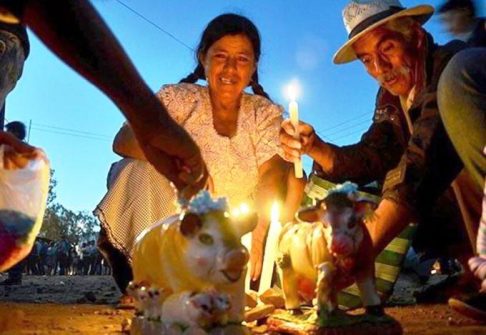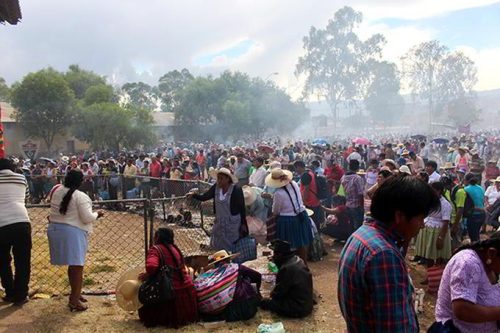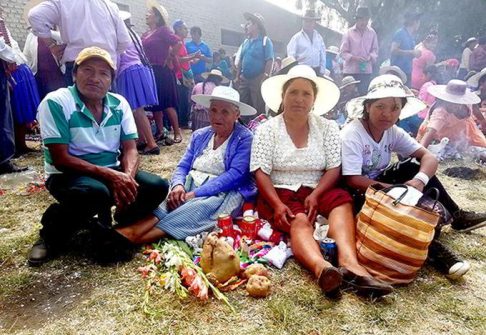Bolivia. Santa Vera Cruz Tatala, the feast of fertility.

The feast of Santa Vera Cruz marks the end of the harvest and the beginning of a new life cycle. It is considered the fertility feast for the regeneration of human and animal life.
According to oral narratives, the festival was anciently celebrated on a stone bearing the sign of a cross, a symbol of the encounter between cyberspace and Pachamama (mother earth), because the Andean cosmovision must be understood starting from the beginning
of yanantin or parity.
For Andean communities, there is no ch’ulla (the odd or singular number), everything has its partner and therefore life continues in pacha (time and space). This is why the encounter of two beings generates life.
It can therefore be said that life in the Andean world is regenerated by the encounter between external space, from which rain and solar rays fall, and the earth that receives them.

Santa Vera Cruz is the second most important festival in the department of Cochabamba. Photo Eco de Tarija.
The Tatala festival expresses this encounter in a ritual sense through pilgrims. Currently, however, it is intertwined with the Christian cross, that is, between ancestral and Christian spirituality. The stone has been replaced by the Christian cross, but the ancestral elements remain.
The central celebration is on May 3, but it begins on the evening of May 2, including the night, and ends on May 9. It lasts all week because pilgrims come from the four cardinal points to perform their ritual at Tatala. On May 2, starting at seven in the evening, devout pilgrims begin to arrive to make their offerings and perform their ritual expressions. From seven o’clock, the ceremonies at the Tatala begin.
Some bring the best fruits they have harvested, such as corn, potatoes, wheat, pumpkins and other products, as a sign of gratitude to the Tatala for its blessing. They retreat to a certain distance, leaving their offerings at the foot of the cross and there they prepare their altar with images of animals: a sheep, a cow or a pig, according to their wishes.

Pilgrims come from the four cardinal points to perform their ritual at Tatala. Photo: Bol.gov
They burn their manure with candles and surround it with stones as a fence. While the cow dung burns, the owners begin to recite the ch’alla (a kind of invocation to Mother Earth) and the pijchean (sharing coca leaves). In this way they express gratitude and at the same time ask for the blessing of the Tatala.
As they become animated with the drink, they continue the couplets dedicated to the Tatala. With these, they express their feelings. Then they sing their songs to the sound of the accordion or charango, accompanied by the guitar, and dance to the rhythm of the music in a group.On the other hand, they also sing in counterpoint, both between men and between women, in a romantic perspective that depends on their spontaneous inspirations. This also depends on the moment they are living or their feelings.
Those who make lamps for their animals and their products see how the dung and the candle are consumed. In their ch’alla and in the sharing of the coca they ask for the blessing of the Tatala so that the animals can multiply, be protected from diseases, etc. That is why, once the meal is finished, they wait for it to cool and then take it home in a container. Once home, they scatter the ashes in the corral of their livestock as a sign of blessing, protection and so that they multiply. In this way, there will always be food for the family and the community.

Three generations attending the Tatala Festival. Photo: Cenda
However, other families will ask for a child, so those interested must take a doll that families who have already had a child bring as a sign of gratitude and leave it at the foot of the cross. Then those interested pick it up and take it home until next year, when they will have to return it to other families who need it, especially new ones who ask for it. This rite has a special meaning for them: to have a healthy child and to obtain it from the God of life through this sign.
The feast of Santa Vera Cruz Tatala embodies the sense of regeneration, the beginning of new times and a life lived to the full. You can see that expression in the pilgrims of the communities who come with their offerings to ask for an abundance of produce, to express gratitude for what they have received this year and, in some cases, to ask for better weather, if they have not had good harvests, or even to complain to the Tatala about his couplets. For a whole week, this festival is celebrated, where the four cardinal points meet. After a week, it ends with the arrival of the last pilgrims and the image is kept in the sanctuary of Santa Vera Cruz until next year.
Santa Vera Cruz is the second most important festival in the department of Cochabamba. Every year, it welcomes more than 40 thousand pilgrims. (Open Photo: Bolivian young Lady) – (Pixabay)
Jhonny Mancilla Pérez



